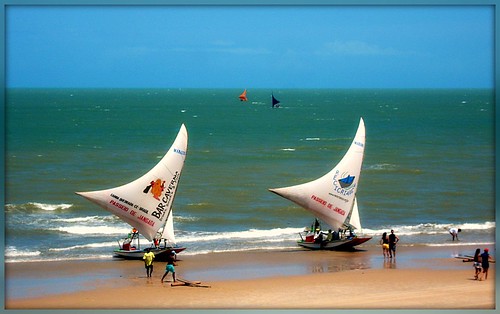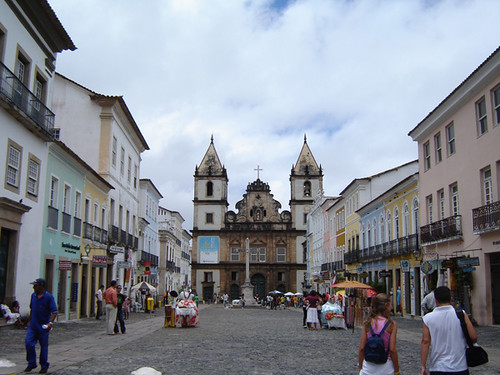
In reality there are many places in Brazil to enjoy sun and sand, of course I mean the beaches, which are spread along its Atlantic coast. Of which we mention below the most visited by tourists:
Salvador de Bahia:
The beaches are the inevitable appeal of the Brazilian Northeast, where the sun shines all year round and holds a paradisiacal sea diversity. Moreover, this region contains some of the oldest and most famous cities of Brazil: Salvador, founded by Portuguese colonizers in 1549, Olinda, where Maurice of Nassau left the stamp of culture Netherlands, Fortress, with its traditional «rafts» cutting sea, São Luís, and its historic architecture Lusitanian tiles, and Natal, a key point of the raids carried out by the colonizers. Through these cities has been weaving a tumultuous tour of beaches and stories, rising, step by step, from the magic of Bahia to the expected peace of Rio Grande do Norte.

Recife:
Deep stories survive in the State of Pernambuco, where the traces are preserved by the Netherlands during a two-decade occupation. The capital, Recife, embodies a perfect synthesis between the colonial past and the modernity of a thriving metropolis. But surely the urban charm to be found, in Olinda, an ancient city declared in 1982 Natural and Cultural Heritage of Humanity. Its imposing churches and the mysteries of their monasteries, spread over seven hills, and is only recommended to go and get lost in its streets.
To get away from concrete and rest on landscape surrounded by coral reefs, natural pools and warm clear sea, the right choice will Cabo de Santo Agostinho, 37 kilometers south of Recife, where you can enjoy activities like horseback riding or visits to church São Gonzalo, built in the sixteenth century, and the old Fort of São Francisco Xavier.
Fortaleza:
Here we are in Ceará, which is a booming state economy whose famed capital, Fortaleza, has one of the most important networks of accommodations and restaurants in the Northeast of Brazil. The «rafts» (fishing boats triangular sail) offer here a distinctive image and is also lobster dish is that you can not stop tasting. Touring the urban environment, highlighting the beaches of Meireles, Volta Mucuripe Jurema and interconnected by the unusual route of the Avenue Beira-Mar, who has been weaving seafood restaurants and hotels that stand out among some very modern, like the imposing Five stars Seara Praia Hotel, on Meireles.
In nearby Ponta das Dunas, a huge aquatic complex with «the highest water slide in the world» and entertainment programs leading to Beach Park, a resort where no lack of services such as tennis courts, spa and sauna. Beach Park is an alternative that may be interesting to know, but to deepen the charms of Ceará, which will necessarily also reach beaches like Jericoacoara and Nova Tatajuba, located west of the capital and only accessible by land and in vehicles double traction.
To the east, 165 kilometers from Fortaleza, another option that has gained fame as one of the most beautiful beaches of this state is Canoa Quebrada, a charming seaside resort that still has the air of the 70’s, when he was considered a paradise for hippies and bohemians who came to seek peace pure and natural. It is a peaceful option, but without falling into the rugged solitude of Jericoacoara, has varieties of accommodations in inns or typical options such as Porto Canoa Resort, a hotel nestled among the dunes that line the beach.
San Luis:
The location, close to the equator, Maranhão presents average annual temperatures of 24 ° C all year that invite you to enjoy the sea breezes on a coastline full of beaches. Reaching far inevitably involves an initial tour of the state capital, São Luiz. Its narrow streets and its buildings, recalling the days of the Lusitanian empire, the town considered World Heritage by UNESCO. Most old buildings are presented with facades decorated with tiles highlight the legacy of Portuguese colonization. Outstanding Leões Palace, which until 1615 the fort that protected the then capital of France Equator (as it was called São Luís during French rule), the Sé Cathedral, built by the Jesuits in 1726, and the Teatro Arthur Azevedo , which in 1817 became the first Grand Theater of the Country.

Besides these architectural attractions, Maranhão reserves pleasant surprises marked by nature, like the National Park Lençóis Maranhenses Paranaiba River Delta with its ecological refuges and creeks Mazes (narrow natural channels between islands), and the reefs of Parcel Manoel Luís, Perhaps the biggest coral reef in South America.
Refuge near a coastline full of beaches, Maranhão also hides a very special place: an area of 150,000 hectares of desert-like white sand, but due to a high average annual rainfall remains transparent lagoons populated much of the year.
Bon Voyage!
Leave a Reply
You must be logged in to post a comment.
Recent Comments